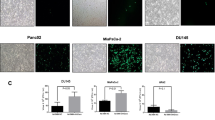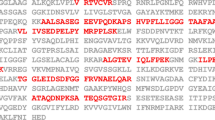Abstract
Human adenoviruses (HAdV) are used as a model system to investigate tumorigenic processes in mammalian cells where the viral oncoproteins E1A and E1B-55K are absolutely required for oncogenic transformation, because they simultaneously accelerate cell cycle progression and inhibit tumor suppressor proteins such as p53, although the underlying mechanism is still not understood in detail. In our present study, we provide evidence that E1B-55K binding to the PML-NB component Sp100A apparently has an essential role in regulating adenovirus-mediated transformation processes. Specifically, when this E1B-55K/Sp100A complex recruits p53, Sp100A-induced activation of p53 transcriptional activity is effectively abolished. Hence, Sp100A exhibits tumor-suppressive activity, not only by stabilizing p53 transactivation but also by depressing E1A/E1B-55K-mediated transformation. E1B-55K counteracts this suppressive activity, inducing Sp100A SUMOylation and sequestering the modified cellular factor into the insoluble matrix of the nucleus or into cytoplasmic inclusions. These observations provide novel insights into how E1B-55K modulates cellular determinants to maintain growth-promoting activity during oncogenic processes and lytic infection.
This is a preview of subscription content, access via your institution
Access options
Subscribe to this journal
Receive 50 print issues and online access
$259.00 per year
only $5.18 per issue
Buy this article
- Purchase on Springer Link
- Instant access to full article PDF
Prices may be subject to local taxes which are calculated during checkout







Similar content being viewed by others
References
Guldner HH, Szostecki C, Grotzinger T, Will H . IFN enhance expression of Sp100, an autoantigen in primary biliary cirrhosis. J Immunol 1992; 149: 4067–4073.
Grotzinger T, Sternsdorf T, Jensen K, Will H . Interferon-modulated expression of genes encoding the nuclear-dot-associated proteins Sp100 and promyelocytic leukemia protein (PML). Eur J Biochem 1996; 238: 554–560.
Newhart A, Negorev DG, Rafalska-Metcalf IU, Yang T, Maul GG, Janicki SM . Sp100A promotes chromatin decondensation at a cytomegalovirus-promoter-regulated transcription site. Mol Biol Cell 2013; 24: 1454–1468.
Moller A, Sirma H, Hofmann TG, Staege H, Gresko E, Ludi KS et al. Sp100 is important for the stimulatory effect of homeodomain-interacting protein kinase-2 on p53-dependent gene expression. Oncogene 2003; 22: 8731–8737.
Seeler JS, Marchio A, Losson R, Desterro JM, Hay RT, Chambon P et al. Common properties of nuclear body protein SP100 and TIF1alpha chromatin factor: role of SUMO modification. Mol Cell Biol 2001; 21: 3314–3324.
Guldner HH, Szostecki C, Schroder P, Matschl U, Jensen K, Luders C et al. Splice variants of the nuclear dot-associated Sp100 protein contain homologies to HMG-1 and a human nuclear phosphoprotein-box motif. J Cell Sci 1999; 112: 733–747.
Sternsdorf T, Jensen K, Reich B, Will H . The nuclear dot protein sp100, characterization of domains necessary for dimerization, subcellular localization, and modification by small ubiquitin-like modifiers. J Biol Chem 1999; 274: 12555–12566.
Seeler JS, Marchio A, Sitterlin D, Transy C, Dejean A . Interaction of SP100 with HP1 proteins: a link between the promyelocytic leukemia-associated nuclear bodies and the chromatin compartment. Proc Natl Acad Sci USA 1998; 95: 7316–7321.
Stepp WH, Meyers JM, McBride AA . Sp100 provides intrinsic immunity against human papillomavirus infection. MBio 2013; 4: e00845–13.
Ling PD, Peng RS, Nakajima A, Yu JH, Tan J, Moses SM et al. Mediation of Epstein-Barr virus EBNA-LP transcriptional coactivation by Sp100. EMBO J 2005; 24: 3565–3575.
Kim YE, Lee JH, Kim ET, Shin HJ, Gu SY, Seol HS et al. Human cytomegalovirus infection causes degradation of Sp100 proteins that suppress viral gene expression. J Virol 2011; 85: 11928–11937.
Adler M, Tavalai N, Muller R, Stamminger T . Human cytomegalovirus immediate-early gene expression is restricted by the nuclear domain 10 component Sp100. J Gen Virol 2011; 92: 1532–1538.
Gunther T, Schreiner S, Dobner T, Tessmer U, Grundhoff A . Influence of ND10 components on epigenetic determinants of early KSHV latency establishment. PLoS Pathog 2014; 10: e1004274.
Berscheminski J, Wimmer P, Brun J, Ip WH, Groitl P, Horlacher T et al. Sp100 isoform-specific regulation of human Adenovirus type 5 (Ad5) gene expression. J Virol 2014; 88: 6076–6092.
Wimmer P, Schreiner S, Everett RD, Sirma H, Groitl P, Dobner T . SUMO modification of E1B-55K oncoprotein regulates isoform-specific binding to the tumour suppressor protein PML. Oncogene 2010; 29: 5511–5522.
Sieber T, Dobner T . Adenovirus type 5 early region 1B 156 R protein promotes cell transformation independently of repression of p53-stimulated transcription. J Virol 2007; 81: 95–105.
Schreiner S, Wimmer P, Groitl P, Chen SY, Blanchette P, Branton PE et al. Adenovirus type 5 early region 1B 55K oncoprotein-dependent degradation of cellular factor Daxx is required for efficient transformation of primary rodent cells. J Virol 2011; 85: 8752–8765.
Endter C, Dobner T . Cell transformation by human adenoviruses. Curr Top Microbiol Immunol 2004; 273: 163–214.
Yew PR, Berk AJ . Inhibition of p53 transactivation required for transformation by adenovirus early 1B protein. Nature 1992; 357: 82–85.
Teodoro JG, Branton PE . Regulation of p53-dependent apoptosis, transcriptional repression, and cell transformation by phosphorylation of the 55-kilodalton E1B protein of human adenovirus type 5. J Virol 1997; 71: 3620–3627.
Pennella MA, Liu Y, Woo JL, Kim CA, Berk AJ . Adenovirus E1B 55-kilodalton protein is a p53-SUMO1 E3 ligase that represses p53 and stimulates its nuclear export through interactions with promyelocytic leukemia nuclear bodies. J Virol 2010; 84: 12210–12225.
Wimmer P, Berscheminski J, Blanchette P, Groitl P, Branton PE, Hay RT et al. PML isoforms IV and V contribute to adenovirus-mediated oncogenic transformation by functional inhibition of the tumor suppressor p53. Oncogene e-pub ahead of print 16 March 2015.
Endter C, Hartl B, Spruss T, Hauber J, Dobner T . Blockage of CRM1-dependent nuclear export of the adenovirus type 5 early region 1B 55-kDa protein augments oncogenic transformation of primary rat cells. Oncogene 2005; 24: 55–64.
Endter C, Kzhyshkowska J, Stauber R, Dobner T . SUMO-1 modification required for transformation by adenovirus type 5 early region 1B 55-kDa oncoprotein. Proc Natl Acad Sci USA 2001; 98: 11312–11317.
Ornelles DA, Shenk T . Localization of the adenovirus early region 1B 55-kilodalton protein during lytic infection: association with nuclear viral inclusions requires the early region 4 34-kilodalton protein. J Virol 1991; 65: 424–429.
Lethbridge KJ, Scott GE, Leppard KN . Nuclear matrix localization and SUMO-1 modification of adenovirus type 5 E1b 55K protein are controlled by E4 Orf6 protein. J Gen Virol 2003; 84: 259–268.
Härtl B, Zeller T, Blanchette P, Kremmer E, Dobner T . Adenovirus type 5 early region 1B 55-kDa oncoprotein can promote cell transformation by a mechanism independent from blocking p53-activated transcription. Oncogene 2008; 27: 3673–3684.
Goodrum FD, Shenk T, Ornelles DA . Adenovirus early region 4 34-kilodalton protein directs the nuclear localization of the early region 1B 55-kilodalton protein in primate cells. J Virol 1996; 70: 6323–6335.
Muller S, Dobner T . The adenovirus E1B-55K oncoprotein induces SUMO modification of p53. Cell Cycle 2008; 7: 754–758.
Nevels M, Spruss T, Wolf H, Dobner T . The adenovirus E4orf6 protein contributes to malignant transformation by antagonizing E1A-induced accumulation of the tumor suppressor protein p53. Oncogene 1999; 18: 9–17.
Li W, Shang C, Guan C, Zhang Y, Sun K, Fu W . Low expression of Sp100 in laryngeal cancer: correlation with cell differentiation. Med Sci Monit 2010; 16: BR174–BR178.
Martin ME, Berk AJ . Adenovirus E1B 55K represses p53 activation in vitro. J Virol 1998; 72: 3146–3154.
Negorev D, Ishov AM, Maul GG . Evidence for separate ND10-binding and homo-oligomerization domains of Sp100. J Cell Sci 2001; 114: 59–68.
Gripon P, Rumin S, Urban S, Le Seyec J, Glaise D, Cannie I et al. Infection of a human hepatoma cell line by hepatitis B virus. Proc Natl Acad Sci USA 2002; 99: 15655–15660.
Mitsudomi T, Oyama T, Gazdar AF, Minna JD, Okabayashi K, Shirakusa T . [Mutations of ras and p53 genes in human non-small cell lung cancer cell lines and their clinical significance]. Nihon Geka Gakkai Zasshi 1992; 93: 944–947.
Nevels M, Dobner T . Determination of the transforming activities of adenovirus oncogenes. In: Wold WS, Tollefson AE . (eds). Adenovirus Methods and Protocols Methods in Molecular Medicine. 2nd ed. Humana Press Inc:, Totowa, NJ, 2006, pp 187–195.
Tatham MH, Rodriguez MS, Xirodimas DP, Hay RT . Detection of protein SUMOylation in vivo. Nat Protoc 2009; 4: 1363–1371.
Logan J, Pilder S, Shenk T . Functional analysis of adenovirus type 5 early region 1B. Cancer Cells 1984; 2: 527–532.
Berscheminski J, Groitl P, Dobner T, Wimmer P, Schreiner S . The adenoviral oncogene E1A-13 S interacts with a specific isoform of the tumor suppressor PML to enhance viral transcription. J Virol 2012; 87: 965–977.
Yew PR, Liu X, Berk AJ . Adenovirus E1B oncoprotein tethers a transcriptional repression domain to p53. Genes Dev 1994; 8: 190–202.
Guldner HH, Szostecki C, Schroder P, Matschl U, Jensen K, Luders C et al. Splice variants of the nuclear dot-associated Sp100 protein contain homologies to HMG-1 and a human nuclear phosphoprotein-box motif. J Cell Sci 1999; 112: 733–747.
Muller D, Schreiner S, Schmid M, Groitl P, Winkler M, Dobner T . Functional cooperation between human adenovirus type 5 early region 4, open reading frame 6 protein, and cellular homeobox protein HoxB7. J Virol 2012; 86: 8296–8308.
Schreiner S, Martinez R, Groitl P, Rayne F, Vaillant R, Wimmer P et al. Transcriptional activation of the adenoviral genome is mediated by capsid protein. PLoS Pathog 2012; 8: e1002549.
Sarnow P, Sullivan CA, Levine AJ . A monoclonal antibody detecting the adenovirus type 5-E1b-58Kd tumor antigen: characterization of the E1b-58Kd tumor antigen in adenovirus-infected and -transformed cells. Virology 1982; 120: 510–517.
Marton MJ, Baim SB, Ornelles DA, Shenk T . The adenovirus E4 17-kilodalton protein complexes with the cellular transcription factor E2F, altering its DNA-binding properties and stimulating E1A-independent accumulation of E2 mRNA. J Virol 1990; 64: 2345–2359.
Wimmer P, Blanchette P, Schreiner S, Ching W, Groitl P, Berscheminski J et al. Cross-talk between phosphorylation and SUMOylation regulates transforming activities of an adenoviral oncoprotein. Oncogene 2013; 32: 1626–1637.
Berscheminski J, Wimmer P, Brun J, Ip WH, Groitl P, Horlacher T et al. Sp100 isoform-specific regulation of human Adenovirus type 5 (Ad5) gene expression. J Virol 2014; 88: 6076–6092.
Leppard KN, Shenk T . The adenovirus E1B 55 kd protein influences mRNA transport via an intranuclear effect on RNA metabolism. EMBO J 1989; 8: 2329–2336.
Acknowledgements
We thank Ron Hay, Ellis Jaffray, Roger Everett, Hans Will, Thomas Sternsdorf and Nicole Fischer for providing reagents and scientific discussion. The Heinrich Pette Institute, Leibniz Institute for Experimental Virology is supported by the Freie und Hansestadt Hamburg and the Bundesministerium für Gesundheit (BMG). JB was supported by grant from the Deutsche Forschungsgemeinschaft (DFG) to TD (DO 343/7-1). MT was supported by the Dräger Stiftung. TD is supported by the DFG and the Wilhelm Sander-Stiftung. SS was supported by the Else Kröner-Fresenius-Stiftung and the Deutsche Krebshilfe e. V. Part of this work was supported by the B. Braun Stiftung and the Fonds der Chemischen Industrie.
Author information
Authors and Affiliations
Corresponding authors
Ethics declarations
Competing interests
The authors declare no conflict of interest.
Rights and permissions
About this article
Cite this article
Berscheminski, J., Brun, J., Speiseder, T. et al. Sp100A is a tumor suppressor that activates p53-dependent transcription and counteracts E1A/E1B-55K-mediated transformation. Oncogene 35, 3178–3189 (2016). https://doi.org/10.1038/onc.2015.378
Received:
Revised:
Accepted:
Published:
Issue Date:
DOI: https://doi.org/10.1038/onc.2015.378
This article is cited by
-
Variability of Betweenness Centrality and Its Effect on Identifying Essential Genes
Bulletin of Mathematical Biology (2019)
-
Selection scan reveals three new loci related to high altitude adaptation in Native Andeans
Scientific Reports (2018)



